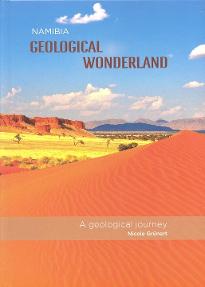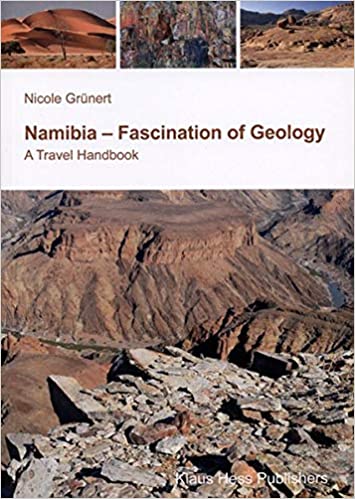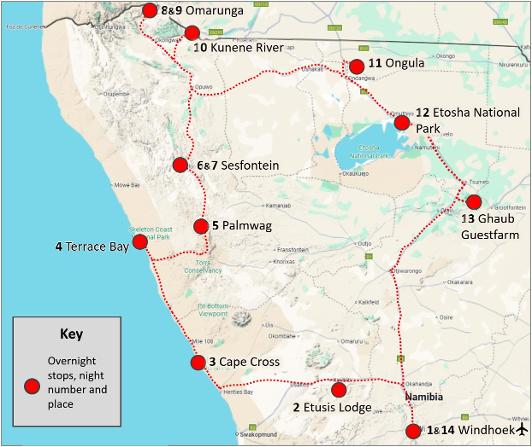** NEW FOR 2026**
North West Namibia
Geology, Wildlife &Culture
Windhoek to Windhoek
Exclusive small group tour. Number of participants: 5-12
15-30 July 2026 *12 spaces*
15 days/14 nights
£4,050
* * * * *
Prices are per person, based on 2 people sharing a room, bed & breakfast accommodation, with dinner when in lodges and camps (11 nights).
Single supplement applies, please make contact for details.
Namibia is one of the most interesting geological destinations in the world. This tour, focusing on the north-western part of the country, offers an opportunity to visit the Skeleton Coast, one of the most remote and dramatic coastlinesin the world, and the awe-inspiring landscape of the Namib Desert, with its towering sand dunes, ancient granite mountains and gravel plains. Alongside the geology, this tour offers a fantastic opportunity to see wildlife and to learn about indigenous cultures.
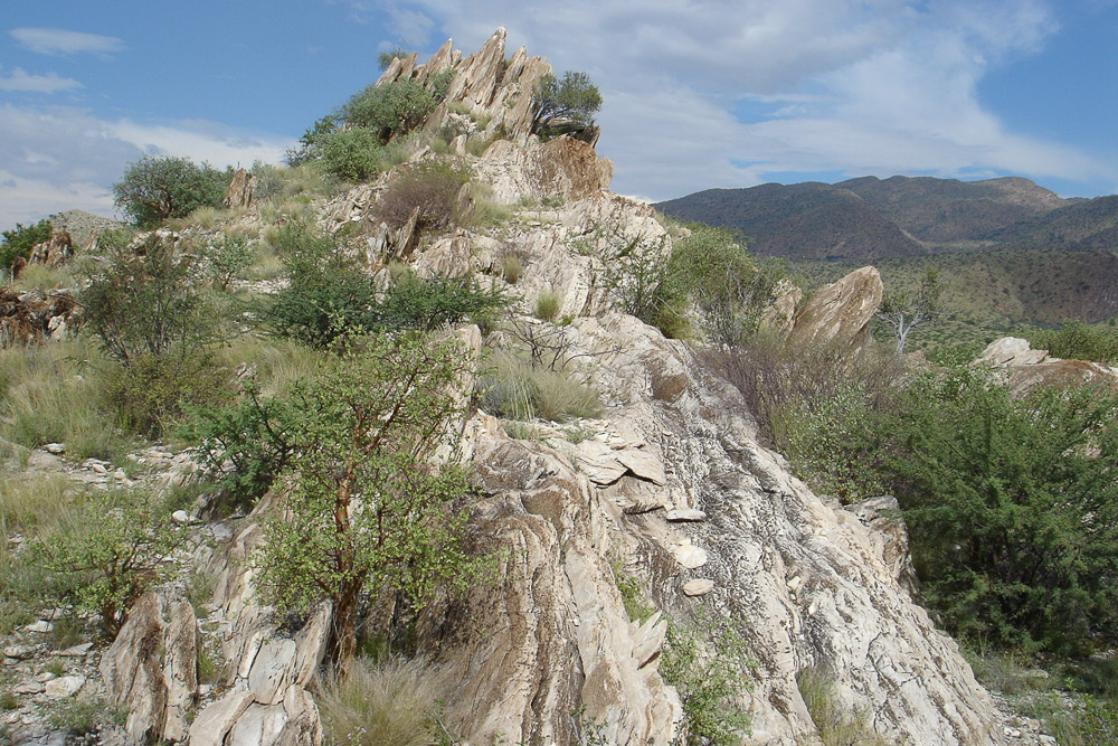
Etusis marble (Day 2)
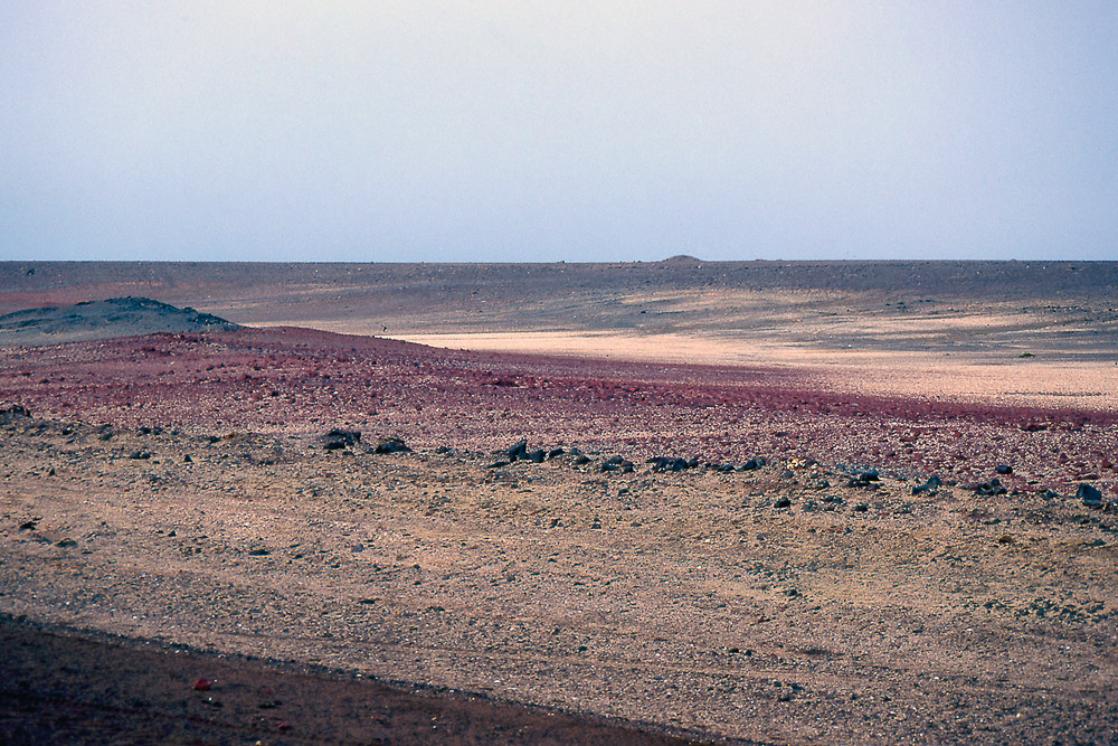
The Skeleton Coast (Day 4)
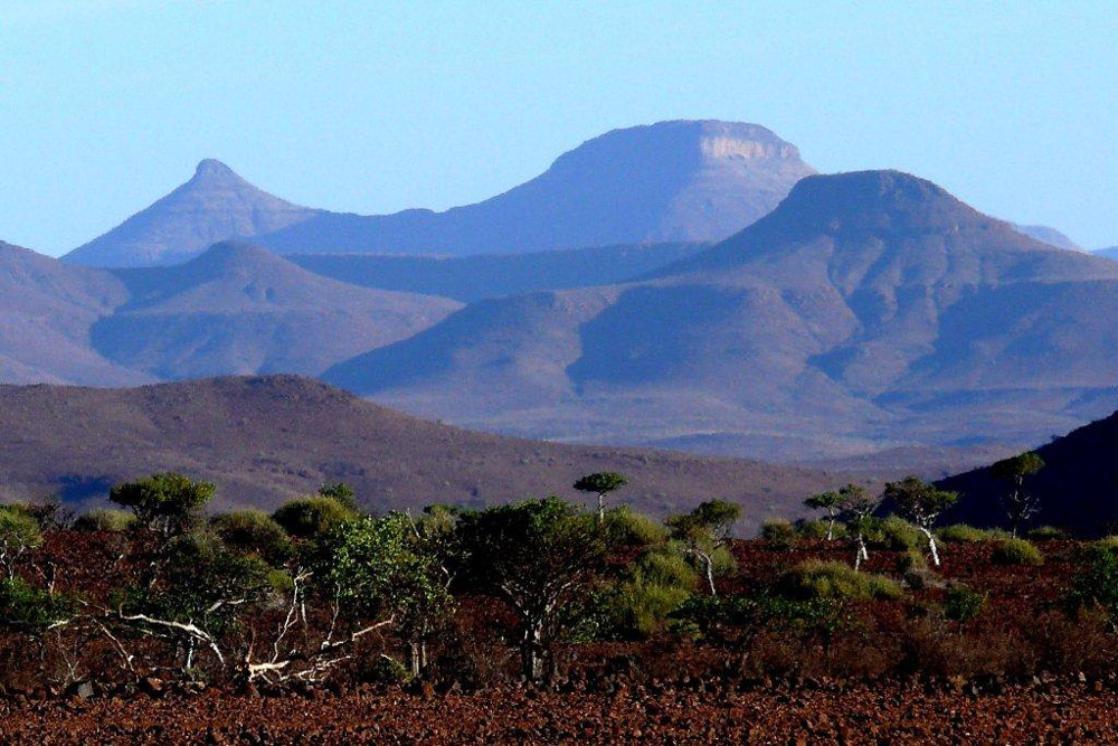
The Etendeka landscape (Day 5)
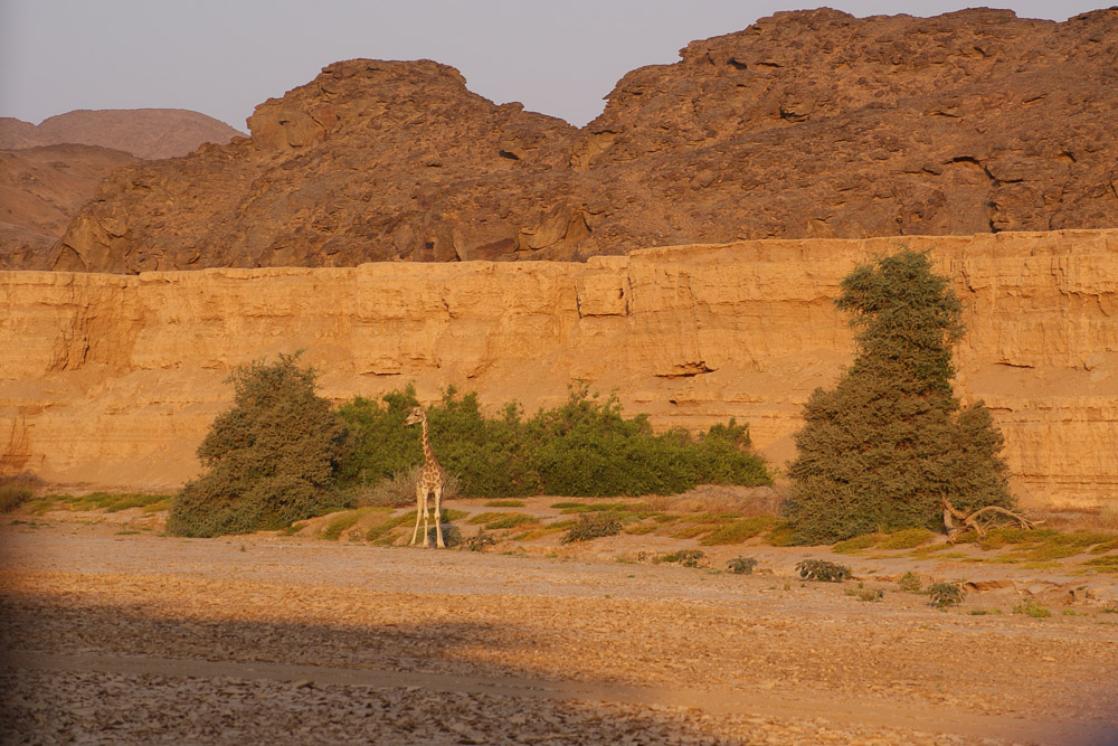
The geology of the Hoanib River (Day 7)
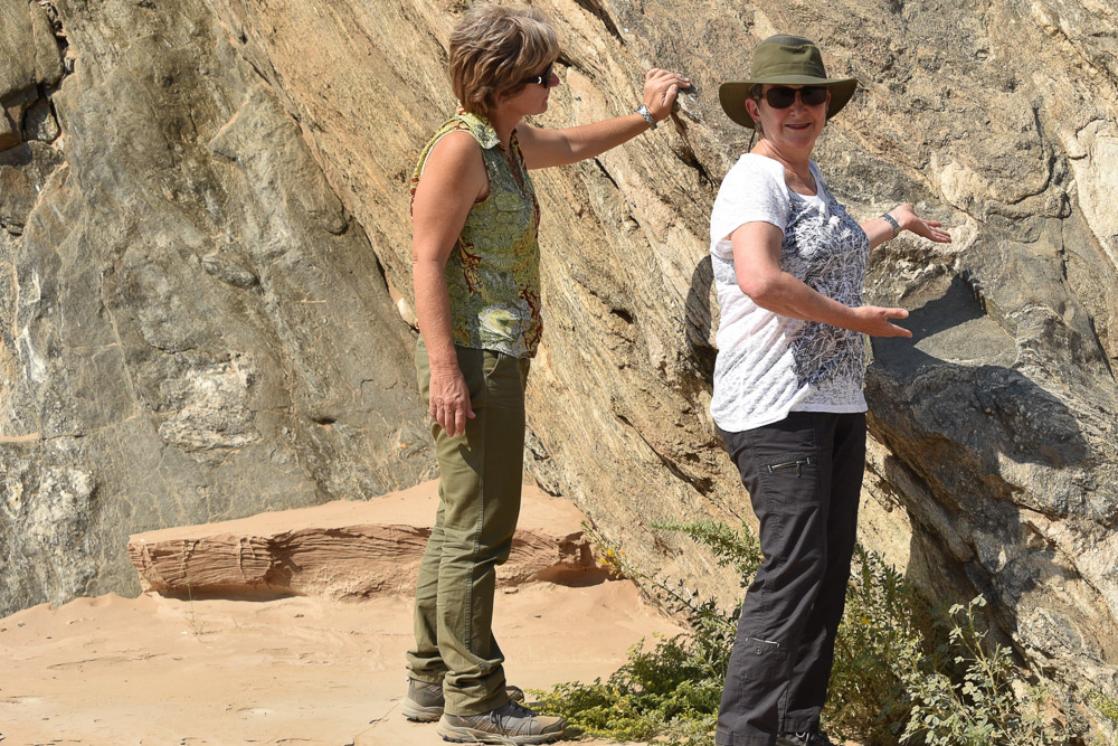
Examining the oldest rocks in Namibia (Day 7)

Epupa Falls (Day 8)
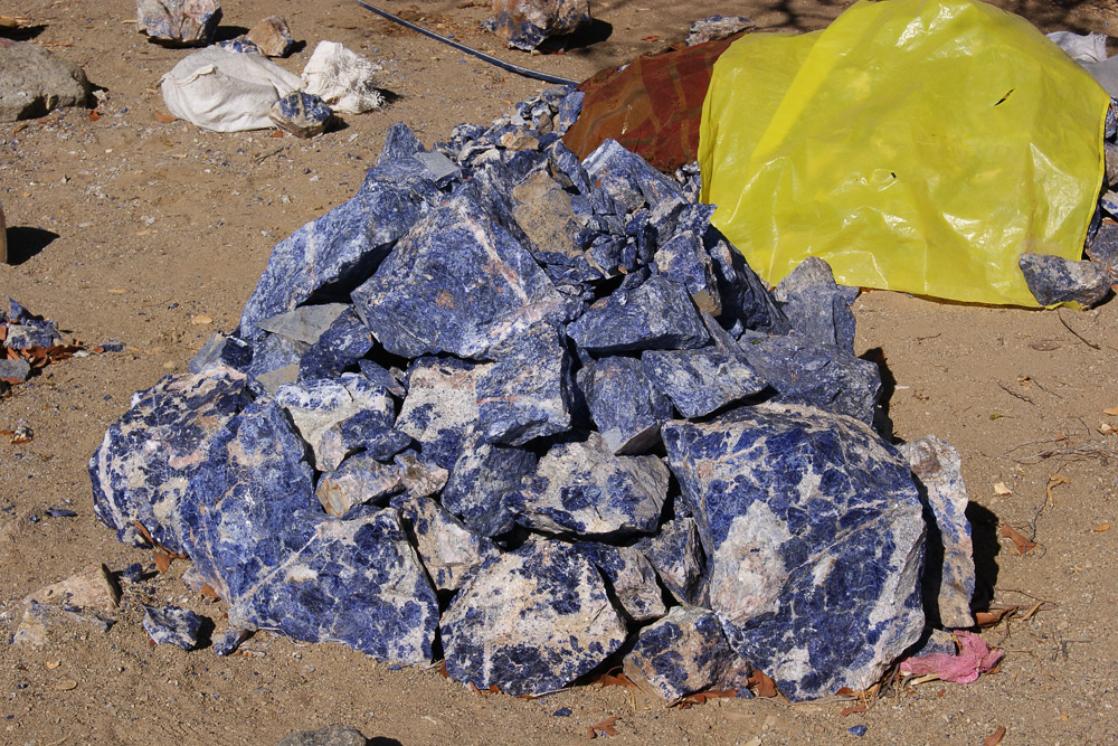
Sodalite, which we will see at the Swartbooisdrift Sodalite Mine (Day 10)

Ruacana Falls (Day 11)
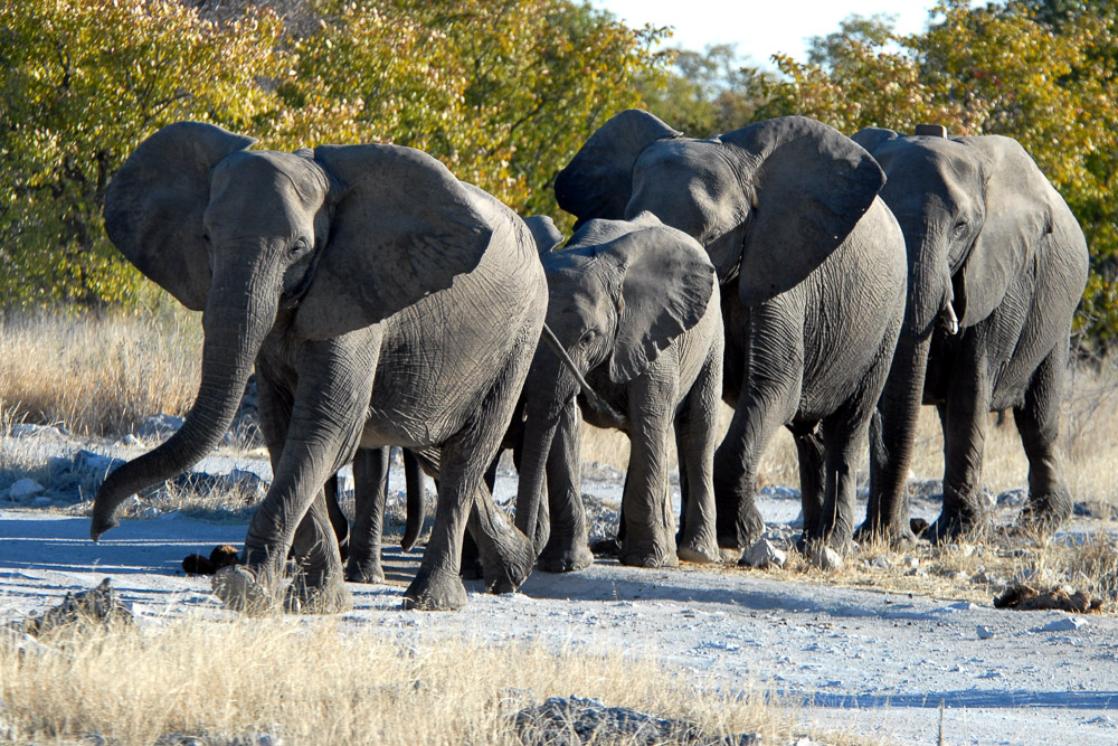
Elephants in Etosha National Park (Day 13)
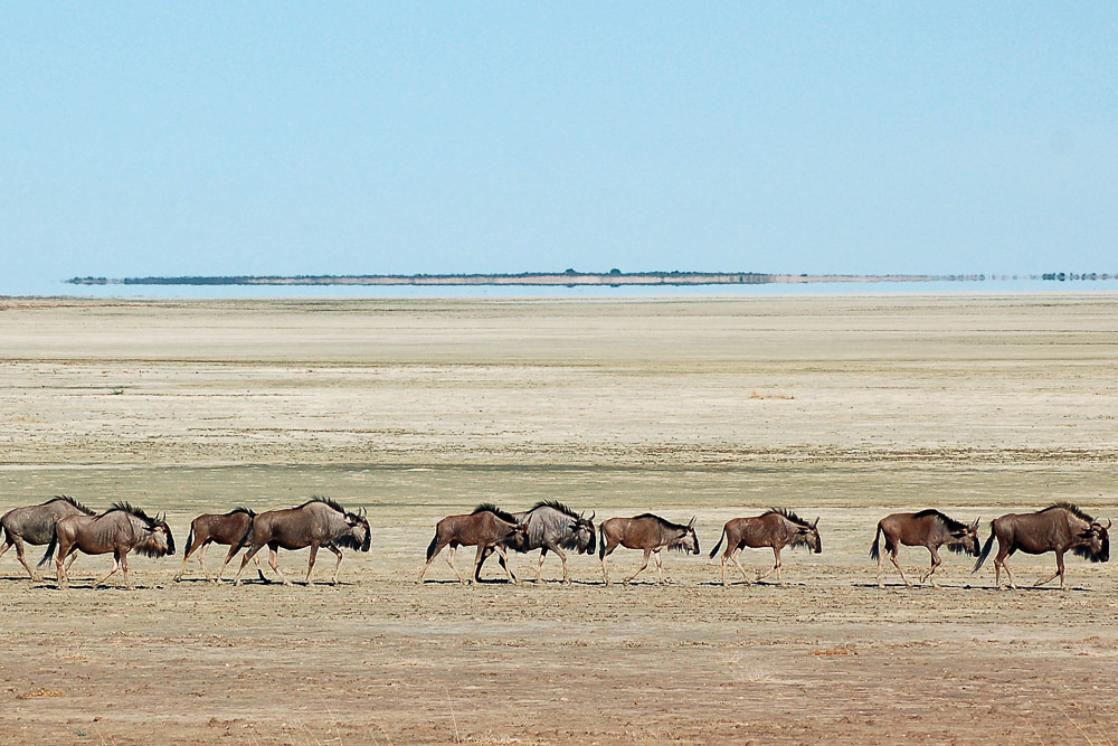
Etosha Salt Pan (Day 13)
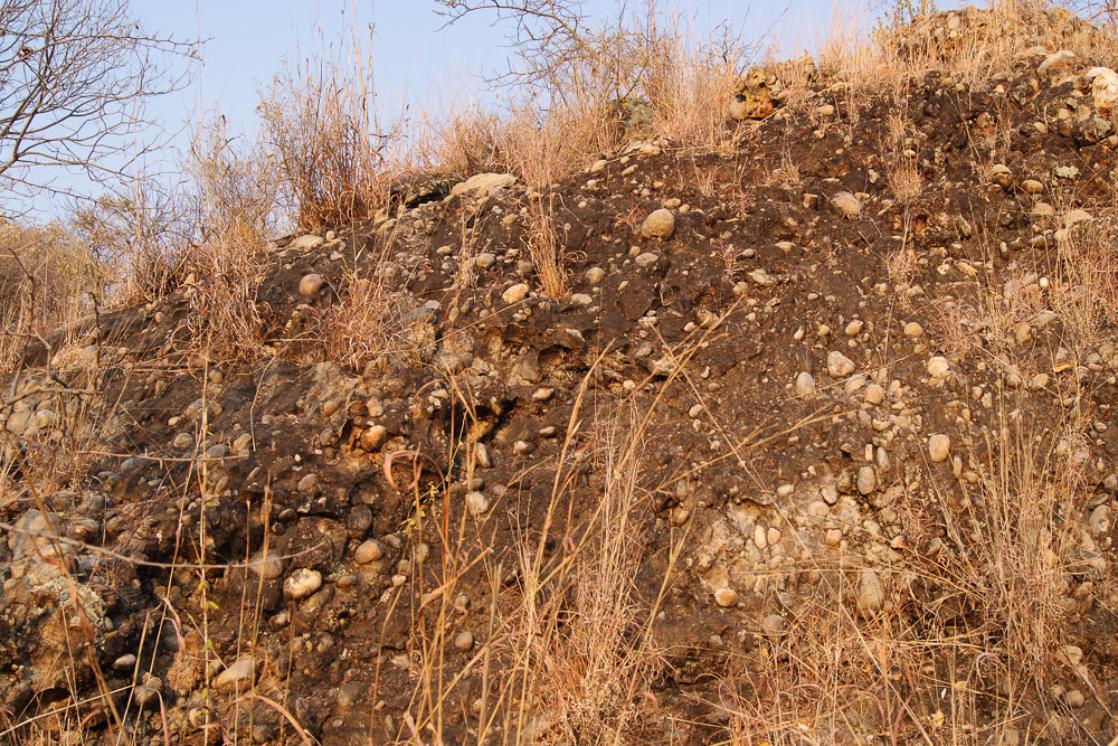
Basal conglomerate (Day 14)
Itinerary
Day 1: Arrival in Windhoek, the capital of Namibia. An airport transfer will be arranged for you, taking you directly to the hotel. The first night of the tour will be spent at the Windhoek Hilton Hotel in the city centre, offering fantastic views of the city. From there you can explore the city on foot. At lunchtime, your geologist guide, Nicole Grünert, will meet you at the hotel and there will be an opportunity to discuss the trip details. The hotel has an on-site restaurant and you will be able to have your evening meal here.
Day 2: The Damara Orogen. We will depart Windhoek in a westerly direction and along the way you will be introduced to the geology of Namibia. Around lunchtime we will arrive at the Etusis Lodge, where we will be spending the night. In the afternoon, an open game-viewer vehicle will take us into the rocky landscape to learn about the geology of the Damara Orogen in this area. With some luck we might be able to spot some antelope, such as springbok or oryx, but we will definitely be able to enjoy a sundowner! Approximate driving time: 3 hours.
Day 3: The Namib Desert to the Atlantic Ocean. Today we will be traversing the gravel plains of the Namib Desert until we reach Cape Cross on the Atlantic Ocean coast. We will enjoy a walk through the seal colony and also learn about the history and geology of the area. We will spend the night at the beautiful and cosy Cape Cross Lodge. Approximate driving time: 3 hours.
Day 4: The Skeleton Coast. We will have a longer day today, driving through the barren but fascinating desert landscape of the Skeleton Coast, sandwiched between the Atlantic Ocean and the barren gravel plains. We will see evidence of diamond mining as well as the remains of a shipwreck, interesting geology and maybe even some wildlife. In the afternoon we will undertake a walk along the beach and look for minerals in this hostile landscape. We will spend the night at the Terrace Bay resort and have dinner at the rustic Fisherman’s bar and restaurant. Approximate driving time: 4 hours.
Day 5: Namib Desert and Gondwana. Leaving the coast today, we will cross the Namib Desert for the last time. We will soon approach table-top volcanic mountains, evidence of the onset of the break-up of the Gondwana Continent. For the rest of the day, we will drive through this beautiful landscape to reach Palmwag Lodge, an oasis in this rocky landscape. In the afternoon we will lean about the geology and participate in a scenic drive in an open game-viewer vehicle. We will spend the night at the famous Palmwag Lodge. Approximate driving time: 3 hours.
Day 6: Etendeka Landscape and the Damara Sequence. We will drive through the Etendeka landscape to the north and reach a region of completely different geology, returning back to the Damara Sequence. In this part of the country the well-known Damara Sequence is carbonate dominated. After exploring some of the geological features, our journey continues in a westerly direction towards Sesfontein. This little settlement was an outpost of the German Schutztruppe. Having arrived at our accommodation, the rest of the afternoon can be spent relaxing by the swimming pool. Our overnight stay will be in the old, colonial Fort Sesfontein. Approximate Driving time: 2 hours.
Day 7: The Hoanib River - wildlife and the oldest rocks in Namibia. Today we will explore the dry riverbed of the Hoanib River, home to the famous desert-adapted elephants, on a guided tour. Not only is this area rich in wildlife, but it also has a geological highlight, as we will visit the oldest rocks in Namibia - an impressive 2,650 million years old. These highly metamorphosed rocks occur next to an interesting feature, named the Hoanib Poort (meaning 'gate' in Afrikaans). Time permitting, we will return to Sesfontein via the Giribis Plains. We will return to Fort Sesfontein for our overnight stay. Driving time: we will be driving the whole day but have very many stops along the road.
Day 8: Kaokoland and the Kunene River. The planned itinerary for today will take us through Kaokoland, the home of the Himba nomadic people, up to the Kunene River. The Kunene River forms the border between Namibia and Angola here. Along the route we will have several interesting geological and botanical stops. Time permitting, we will stop to visit over at an old dioptase mine, which is situated along the road. Our overnight stay will be at the Omarunga Camp on the banks of the Kunene River. Approximate driving time: we will be driving the whole day but have very many stops along the road.
Day 9: Kunene River, Himba Village and Epupa Falls. Waking up with the sound of flowing water, a rarity in Namibia, today is planned to be a more relaxed day. After breakfast we will take a guided tour to a Himba village and learn more about their culture and believes. We will than have a lunch break before we explore the geology along the Kunene River and visit the Epupa Falls. We will return to the Omarunga Camp for our second night here. Approximate driving time: 2 hours.
Day 10: Mineral Mines and the Kunene River. This is the day for the mineralogists! After a 2-3 hour drive we will get to the Swartbooisdrift Sodalite Mine. This site not only hosts these fascinating deep blue rocks but is also in the process of developing one of the first rare-earth mines in Namibia. We plan to get an introduction to the mining operations and visit one of the open pits. After in interesting day full of geology we will head back to the Kunene River, further to the south-east than the last two nights, and spend the night at the Kunene River Lodge. Approximate driving time: 4 hours.
Day 11: Kunene River, Ruacana Falls and Owamboland. Our route today starts with a scenic drive along the Kunene River towards Ruacana. We visit the Ruacana Falls and the hydro-electric power station. The next part of our journey will take us through Owamboland, home to the biggest ethnic group in Namibia, the Owambo people. We will see how the Ovambo live, both traditionally and also in the modern world. As a highlight, our overnight stay will be at the Ongula Traditional Homestead in well-equipped bungalows with en-suite bathrooms. In the late afternoon we will walk through the nearby township and learn about the traditional food and entertainment of the Owambo people. Approximate driving time: 4 hours.
Day 12: Etosha National Park. Today is game-viewing time! After a short drive, we enter the Etosha National Park and spend the whole day game-viewing. We will also, of course, be looking at the geology of the Etosha Salt Pan. If we are lucky, we will see lots of wildlife, including elephants, lion, or even a black rhino. Our overnight stay will be at the fantastic King Nehale Lodge. Approximate driving time: we will drive most of the day, visiting waterholes for game viewing.
Day 13: Tsumeb, Otavi Mountainland and the Damara System. Heading back south we will stop at the mining town of Tsumeb and visit the open pit of this famous locality. Our next stop will be in the Otavi Mountainland where we will explore the interesting geology of the Damara System of the Northern Platform. We will arrive at Ghaub Guestfarm where we will stay overnight. Approximate driving time: 4 hours.
Day 14: Return to Windhoek. Today we will cover a long distance to get back to Windhoek, but most of it is on tarmac roads. Our accommodation will be at the Hotel Thule in a suburb of Windhoek. After a long drive you can enjoy the fantastic view from the terrace and an evening meal either at the hotel restaurant or at the nearby, famous Joe’s Beerhouse. Approximate driving time: 5 hours.
Day 15: Geological Museum and departure. In the morning, we will visit the National Earth Sciences Museum, a geological museum which hosts a good display of Namibian geology, earth history, fossils, minerals and operational mines. After the visit we will have a farewell lunch together at a nice garden restaurant before a shuttle takes you to the International Airport for flights departing in the late afternoon/evening.
INCLUDED
Geological guiding from Nicole Grünert
Transfer to/from airport
En-suite guest house, guest farm or safari lodge accommodation
Breakfast
Dinners (11 nights only)
National Park, game reserve and museum entrance fees
NOT INCLUDED
Flights to and from Namibia
Lunches (picnics are bought at shops along the way)
Dinners (3 nights only)
Alcohol and soft drinks
Tips (local restaurants & hotels + guide)
About Nicole and her books
This tour is led by Nicole Grünert, a German Namibian geologist and author of the two books below. There could be no better guide for this tour! To read more about Nicole please click here.
